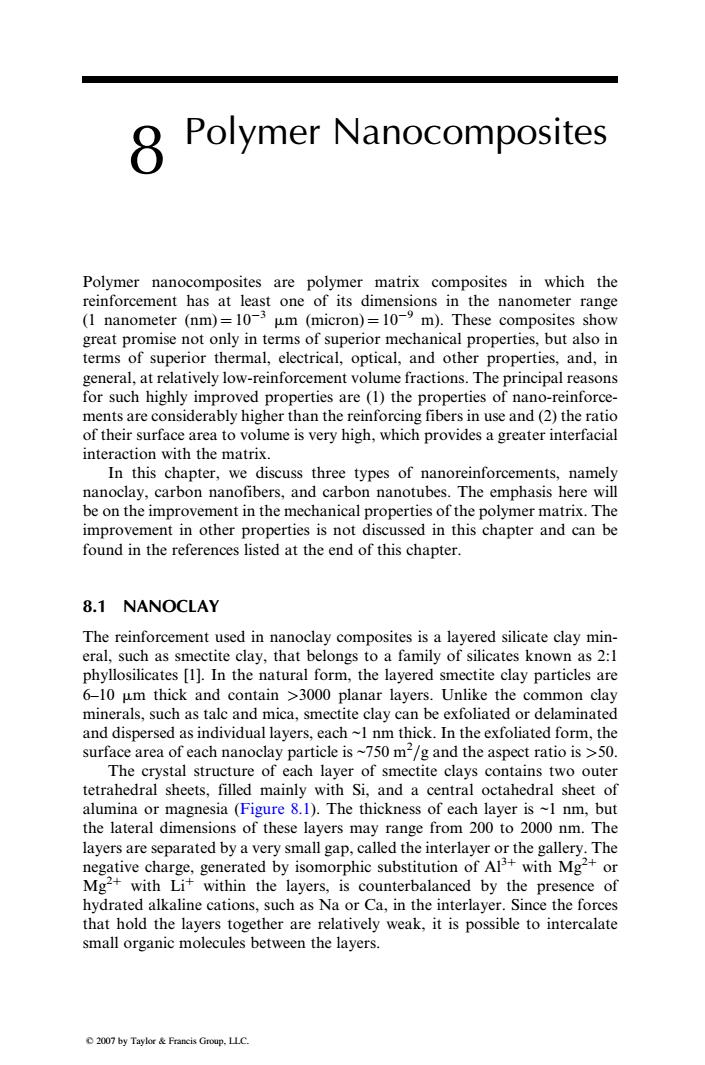正在加载图片...

Polymer Nanocomposites Polymer nanocomposites are polymer matrix composites in which the reinforcement has at least one of its dimensions in the nanometer range (1 nanometer (nm)=10-3 um (micron)=10-9m).These composites show great promise not only in terms of superior mechanical properties,but also in terms of superior thermal,electrical,optical,and other properties,and,in general,at relatively low-reinforcement volume fractions.The principal reasons for such highly improved properties are (1)the properties of nano-reinforce- ments are considerably higher than the reinforcing fibers in use and(2)the ratio of their surface area to volume is very high,which provides a greater interfacial interaction with the matrix. In this chapter,we discuss three types of nanoreinforcements,namely nanoclay,carbon nanofibers,and carbon nanotubes.The emphasis here will be on the improvement in the mechanical properties of the polymer matrix.The improvement in other properties is not discussed in this chapter and can be found in the references listed at the end of this chapter. 8.1 NANOCLAY The reinforcement used in nanoclay composites is a layered silicate clay min- eral,such as smectite clay,that belongs to a family of silicates known as 2:1 phyllosilicates [1].In the natural form,the layered smectite clay particles are 6-10 um thick and contain >3000 planar layers.Unlike the common clay minerals,such as talc and mica,smectite clay can be exfoliated or delaminated and dispersed as individual layers,each ~1 nm thick.In the exfoliated form,the surface area of each nanoclay particle is ~750 m-/g and the aspect ratio is >50. The crystal structure of each layer of smectite clays contains two outer tetrahedral sheets,filled mainly with Si,and a central octahedral sheet of alumina or magnesia(Figure 8.1).The thickness of each layer is ~1 nm,but the lateral dimensions of these layers may range from 200 to 2000 nm.The layers are separated by a very small gap,called the interlayer or the gallery.The negative charge,generated by isomorphic substitution of Al+with Mg2+or Mg2+with Li+within the layers,is counterbalanced by the presence of hydrated alkaline cations,such as Na or Ca,in the interlayer.Since the forces that hold the layers together are relatively weak,it is possible to intercalate small organic molecules between the layers. 2007 by Taylor&Francis Group.LLC.8 Polymer Nanocomposites Polymer nanocomposites are polymer matrix composites in which the reinforcement has at least one of its dimensions in the nanometer range (1 nanometer (nm) ¼ 103 mm (micron) ¼ 109 m). These composites show great promise not only in terms of superior mechanical properties, but also in terms of superior thermal, electrical, optical, and other properties, and, in general, at relatively low-reinforcement volume fractions. The principal reasons for such highly improved properties are (1) the properties of nano-reinforcements are considerably higher than the reinforcing fibers in use and (2) the ratio of their surface area to volume is very high, which provides a greater interfacial interaction with the matrix. In this chapter, we discuss three types of nanoreinforcements, namely nanoclay, carbon nanofibers, and carbon nanotubes. The emphasis here will be on the improvement in the mechanical properties of the polymer matrix. The improvement in other properties is not discussed in this chapter and can be found in the references listed at the end of this chapter. 8.1 NANOCLAY The reinforcement used in nanoclay composites is a layered silicate clay mineral, such as smectite clay, that belongs to a family of silicates known as 2:1 phyllosilicates [1]. In the natural form, the layered smectite clay particles are 6–10 mm thick and contain >3000 planar layers. Unlike the common clay minerals, such as talc and mica, smectite clay can be exfoliated or delaminated and dispersed as individual layers, each ~1 nm thick. In the exfoliated form, the surface area of each nanoclay particle is ~750 m2 =g and the aspect ratio is >50. The crystal structure of each layer of smectite clays contains two outer tetrahedral sheets, filled mainly with Si, and a central octahedral sheet of alumina or magnesia (Figure 8.1). The thickness of each layer is ~1 nm, but the lateral dimensions of these layers may range from 200 to 2000 nm. The layers are separated by a very small gap, called the interlayer or the gallery. The negative charge, generated by isomorphic substitution of Al3þ with Mg2þ or Mg2þ with Liþ within the layers, is counterbalanced by the presence of hydrated alkaline cations, such as Na or Ca, in the interlayer. Since the forces that hold the layers together are relatively weak, it is possible to intercalate small organic molecules between the layers. 2007 by Taylor & Francis Group, LLC.��